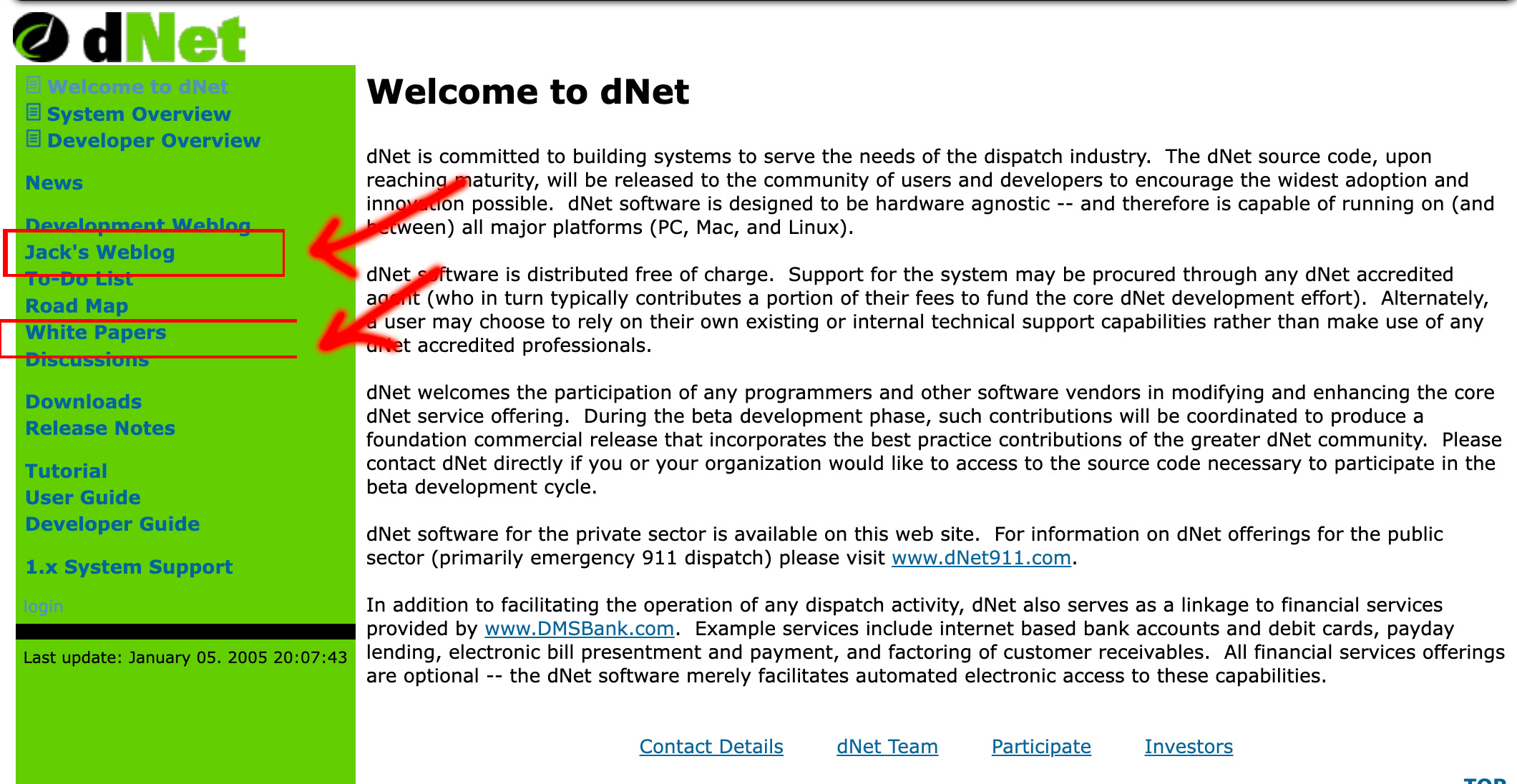This article was a timeline established in February 2024 to flesh out the possibility that Jack Dorsey could be Satoshi Nakamoto. It has since led to more developed and concrete evidence that he is, which can be found here. If you’ve found your way here from a viral X post here’s the same post but with source links.
Jack Dorsey is a proficient coder who in addition to co-founding twitter, founded Square which grew into one of the largest payment companies in the world. Dorsey is also a famous Bitcoin maximalist and has been a public advocate for it since at least 2012. In the present day not only does Square (now Block) derive 50% of its company revenue from selling Bitcoin, but Dorsey has also broadcast loud signals as of late that he is indeed the original Satoshi Nakamoto. Here’s a timeline as to why Jack Dorsey might be Satoshi himself.
1991: At just 15 years old, Dorsey gets his first job as a software developer, a digital publishing company called Mira. He was so good at it that he managed a team of 30-year old programmers.
1996: Jack Dorsey is photographed (top left) wearing an Adam Back RSA perl munitions t-shirt in the 1996 University of Missouri-Rolla yearbook. Adam Back was the first person Satoshi Nakamoto would ever email in 2008.

1998: Jack Dorsey joined DNet with Greg Kidd, a system to fulfill immediate physical delivery of e-commerce orders using free open-source software that relied on a distributed synchronized database. Originally at despatchnet.com it moved to dnet.com in ~March, 2000. On the original site, it said:
Once A to B happens, despatchNet handles the financial settlements to ensure that the monies involved end up in the correct bank accounts for all concerned parties.
[…]
despatchNet is a free, Open Source, web based system and service, available for use by any and all. The source code is freely and fully available to any and all. The system can be run via the network provided by despatchNet, or as an independent system on behalf of a particular user.
Dorsey was the original programmer. Dorsey said the original objective was actually payments over the internet without a need for banks. “We wanted to do a Web-centric dispatch system that would essentially provide an ATM for couriers, most of whom don’t have bank accounts, so they could easily draw their commissions through the Web,” he said.
“DNet’s distributed push-pull architecture automatically ensures that even disparate participants are always interacting with one-another and DNet via a synchronized version of software. At the same time, the DNet architecture of distributed functionality and data ensures providers the ability to perform basic operational capabilities even during outages in access to an external network or database.”
– 2000
“DNet operates as a Federal Reserve-like guarantor of financial settlements between all constituent parties.”
-2000
Dorsey left the company in ~2002 after disagreements. Kidd transitioned to working as a Senior Analyst for the Federal Reserve in 2002 where he worked on “check and ACH clearing systems as well as private sector money transfer systems,” according to his LinkedIn, and was among the very first investors in Coinbase in 2012.
March 8, 1999: Jack is recruiting “punk hackers” to come work at Dnet.
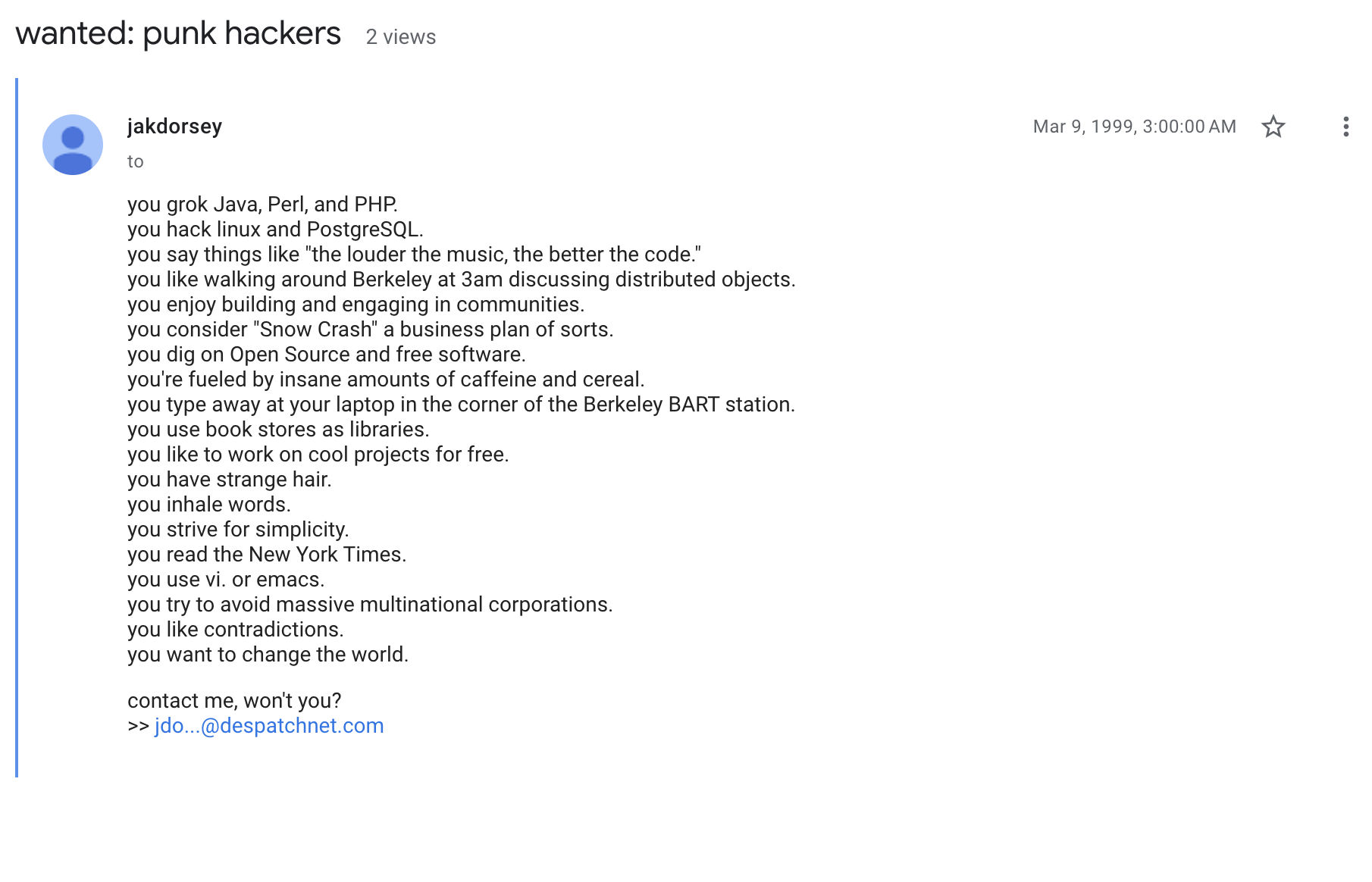
June 22, 1999: Jack tells someone on a mailing list to check out a book about cryptography. This one: https://www.amazon.com/exec/obidos/ASIN/0471117099
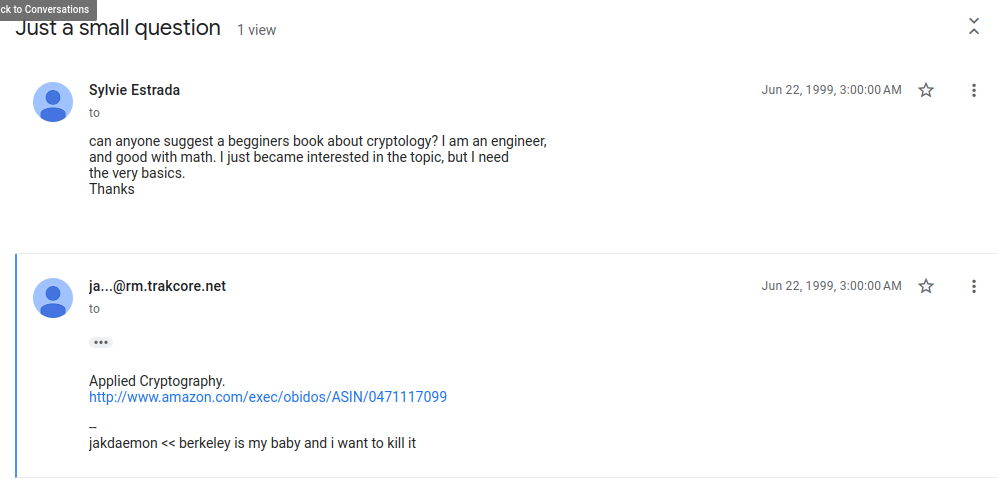
June 28, 1999: Jack touted that a card based crypto system used by Enoch Root, a character in Cryptonomicon by Neal Stephenson, was designed by Bruce Schneier. He linked here: https://www.schneier.com/academic/solitaire/.

November 1999: A post by Jack Dorsey on his personal website trakcore.net, which includes a word ball with the words “crypto core network” diagonally through the center.


June 2000: Dorsey updates his website with hex linked to this url, http://www.keyserver.net:11371/pks/lookup?op=get&search=0xE308B07B. The fingerprint of Dorsey’s PGP Key then was likely:
Key ID: 0xE308B07B
Fingerprint: 9248 2BA6 0687 1606 D377 11A8 2FB0 FF4A E308 B07B
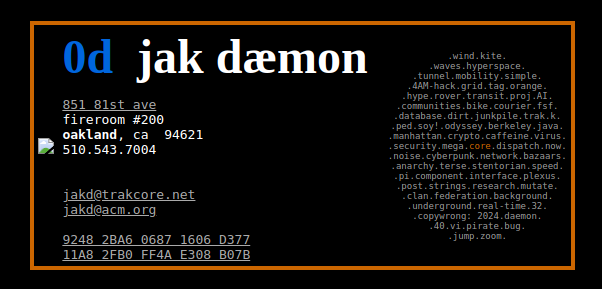
March 2000: Jack Dorsey was a confirmed member of the CypherPunks mailing list, using the name “jak daemon” with a signature that said “living in pirate utopia.” He used his dnet.com email address which meant he was still part of the company. Similarly, his Dnet email still appeared on his digital business card on March 3, 2000.
Additionally, as part of the port over despatchnet.com to dnet.com, Dnet adds a Whitepapers section. to its website. (Also visible here and here)
March 29, 2000: Jack Dorsey joins Advogato.org, an online open source community. He uses the name: jakd
August 4, 2000: Jack is fired from Dnet, as confirmed through his blog entry on it here.
September 2000: The Dnet website goes down for ~3 months and then doesn’t return as anything beyond a “login” screen until early 2002. When it does, it has multiple software packages available to download, all of which are Windows-only and developed by Erik Westra.
November 16, 2000: Jack posts on his blog:
“when i return i’ll dive into my program, or rather network, hardcore. i’ve promised myself that it will be finished by Jan 1st. there are few things that thrill me more than programming in the winter time. by the fire. i have a good start on the network, it’s mainly a collaboration of existing free programs that, when put together, make a very powerful statement. i’ve taken everything i’ve learned from all my sources: cognitive science, ant and bee colonies, couriers, friends, journals, neural nets, food not bombs, tao.ca, immediatism, traveling, veganism, chaos, chuck palahniuk, mozart and bach, DIY, viruses, and mutation and meshed them all up into one big (but rather small core) soup. free for all, if you’ll take it. so, that’s where my head has been the past months. heck. i’ve been leading up to this my whole life.”
November 29, 2000: Jack posts on his blog:
“i’m trying to figure out how to best design my network. it comes down to all neuroscience in it’s arrangement. i need to figure out the base parts though. what is the neuron? is it a webserver or is it homebrew? or a little of both? the answer is somewhere in the deconstruction of my day.”
March 7, 2001: Jack says he is “days into win32 programming.” (He is immd40)
2001 Jack coded and released an incredibly popular freeware app for Mac that even Apple hosted on its website. What’s interesting is that if you zoom in, you can see text he had written into his terminal that starts off with “Make a mark without leaving a trace”
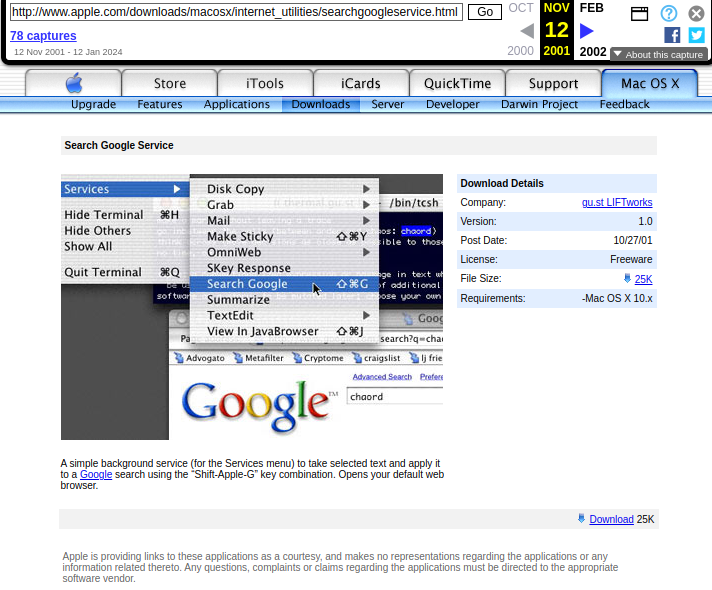
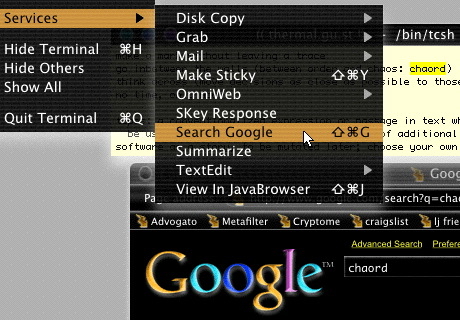
June 2001: Jack Donates to OpenBSD as seen here and confirmed here under the name Jak Daemon.
His browser also shows a bookmark to cryptome.org, a cryptography site often viewed as a pre-cursor to Wikileaks, that would later publish a link asking people to try out Hal Finney’s Hashcash-based Proof of Work tech.
September 7, 2001: Jack joins Metafilter. post 1 (references Windows). post 2. post 3. Comments.
April 16, 2002: Jack discovers Gentoo Linux, which was just introduced for 2 weeks earlier. His user account.
April 29, 2002: Jack begins contributing code and fixes to Gentoo. He is listed as a contributor to Gentoo. Sample of him talking about a bug fix here in multiple comments.
September 2002: DNet announces that it has changed its business model due to economic conditions and would give up the e-commerce focus for the time being.
May 2003: Dorsey identifies himself as being into crypto, pseudonyms, 4am hacking, and nodes.
“jak daemon is your standard, unusual, stentorian, grassroots hacker. jak lives in a chaotic cruise of crypto anarchy, pseudonym federations, 4AM hacks, viral dispatch, reputation taggers, temporary autonomous zones, colony/clan workforces, urban cores, and corporate disorder. jak’s past and current efforts manipulate the background process in small ways to drive various aspects of the world. one node at a time.”
– Jack Dorsey (published on his personal blog now hosted at gu.st. He took down trakcore.net)
** His blog was taken offline on October 30, 2008, which happens to be the day before the bitcoin white paper was introduced to the world by Satoshi.
2003: Jack Dorsey publishes an amended version of his word ball. Keep in mind this graphic was constructed by a 27 year-old, not a kid. Among the words he replaced is “cyberpunk” with “inbetween”, “database” with “zerowork”, “dispatch” with “berkeley.” On the latter, berkeley is the only word that appears twice. Berkeley DB was coincidentally the first database management system that Satoshi used for Bitcoin’s wallet functionality (Dorsey’s mailing address was in Berkeley, CA so could just be coincidence). The word ball also uses the number 32, which happens to match Bitcoin’s SHA-256 cryptographic hashes which are 32 bytes long.
And thus the word ball is striking despite it obviously proving nothing
- Crypto Core Network
- Berkeley (DB)
- 32 (bytes)
- The circular nature of the ball and the orange color of core (Bitcoin’s logo is an orange circle)

2003: “I also wish to end my dependence on the American Dollar ($), and in that vain am setting up a bartering network.” – Jack Dorsey on his blog. He also claims he is proficient enough in the following programming languages to teach them: C, Python, OCaml, JoCaml, Lisp, and ObjC. We also know from his 1999 posts that he was also into Java, Perl, and PHP.
2003: Jack Dorsey previously had a tattoo that said 0daemon?!. “This has multiple meanings which tend to define the ideals closest to me,” Dorsey wrote.
0: symbolizes a zerowork lifestyle. nothing exploding into everything.
0d: hexadecimal for the number 13. living in the 13th hour. one of my favorites. this also symbolizes “0 day” which is another metaphor for immediatism. living for and because of the moment.
daemon: a background angel. in computer terms, a background process. i live in the background. i strive to be behind the curtain with that subtle influence. that’s where i’ve always found myself. i like to dig deep. find out how things function underneath the covers and thoughts. this also points to chaos theory and the butterfly effect.
!: being overly excited and intense throughout life. in every emotion and experience. living with an over abundance of energy that you share with all who will subscribe.
?: living by the idiom “i don’t know.” maintaining a high level of curiosity and skepticism. finding things out for myself and experiencing them to the fullest extent.

Dorsey covered that daemon tattoo over in the years before launching Twitter with a tattoo of a giant S, which he often referred to as an integral.
I have a tattoo. It's the shape of a sound-hole, an integral symbol, and a clavicle bone. http://yfrog.com/5pxv9j
— jack (@jack) June 23, 2009
Dorsey also has “an anarcho black star with an orange half symbolizing anarcho-immediatism which is an idea/dynamic that i enjoy exploring and furthering,” he wrote.
Anarcho-immediatism is a concept created by American anarchist Peter Lamborn Wilson (Hakim Bey), who is famous for coining the phrase “Pirate Utopia” in his 1995 book. Pirate Utopias: Moorish Corsairs & European Renegadoes. Dorsey was so captivated by this that it was included in his tagline in the cypherpunks mailing list in the year 2000. _jakd << living in pirate utopia. Wilson also published T.A.Z.: The Temporary Autonomous Zone, a term Dorsey claimed he was living in.
Jack also rotated between AIM screen names, using the following:
- jakd
- jakgust
- JackZephyr
- jackcommon
- IAMYOUSEE
- rusticrambla
- immd40
- Jackson Commons
- Tinysoul
- Jack #27 / Jack No. 27
And on message boards using the following:
- Cypherpunks: jak_daemon
- Openbsd-tech: jakdaemon_
- Openbsd-ppc: jakd_
- Pythonmac-sig: jack_
- In code: jak¥
- In code: jakd (his file name)
- Foresight Exchange: crakjakd
- Groups on Usenet: tinge
- Groups on Usenet: jakdorsey
- Gmail: [email protected]
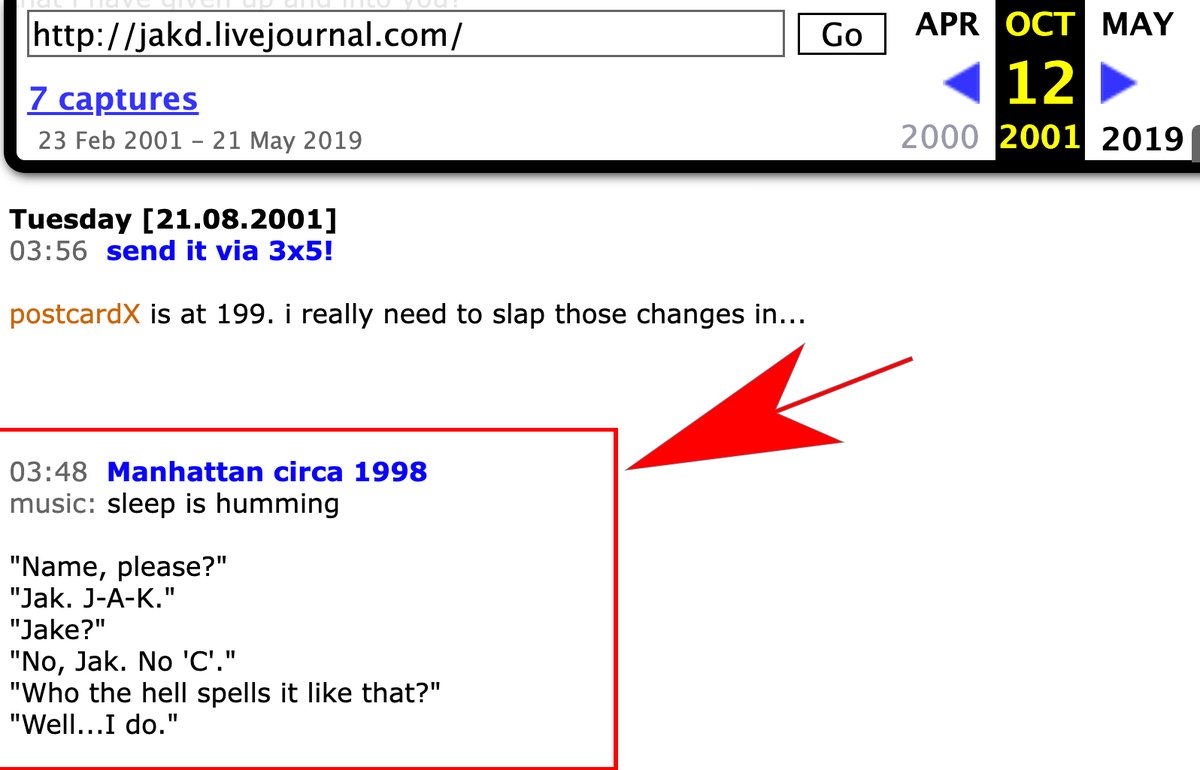
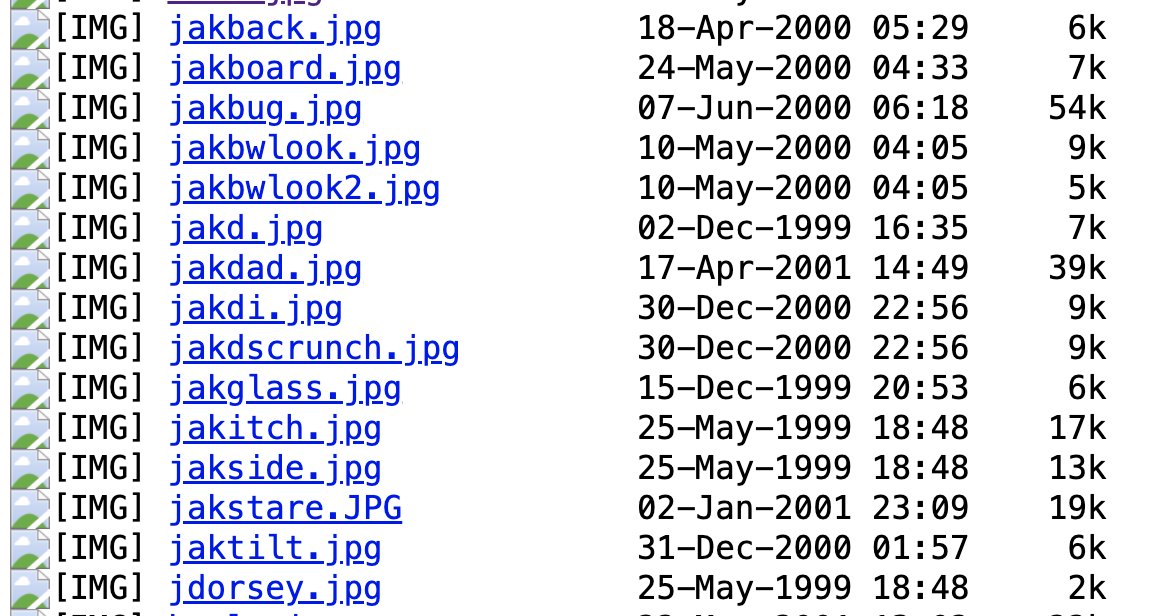
2004: Jack Dorsey moves in with Greg Kidd, the former CEO of DNet. DNet, which was now financially defunct, has shifted to becoming an open-source peer-to-peer network.
June 22, 2004 Jack is personally out of funds and announces that  his websites will be going down indefinitely.
his websites will be going down indefinitely.
June 25, 2004 Jack releases a new software tool called Gmailto. On July 1, 2004, he changed half of the instructions for how to use it into Japanese. Shortly thereafter, he wrote them in Italian, Spanish, and French.

December 2, 2004 Jack makes an appeal for donations using dropcash, a fundraising tool with PayPal as its backend, to bring one of his sites back online, postcardx.net. It was common for Jack to rely on donations for hosting.
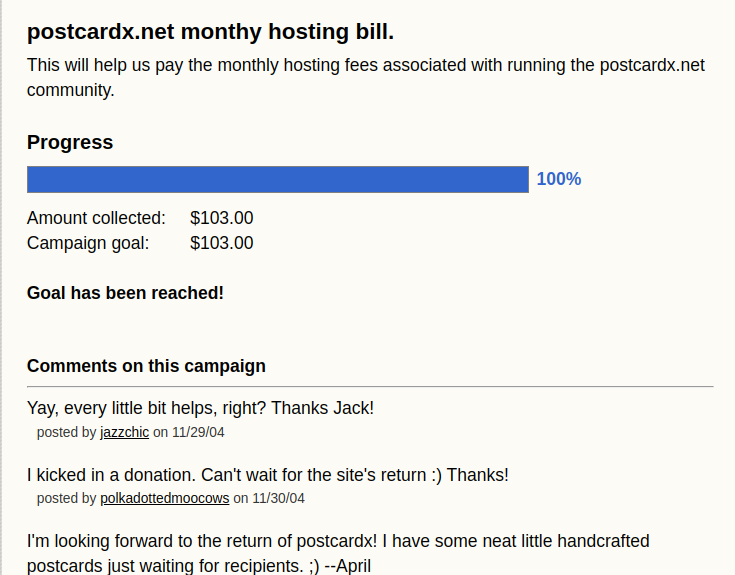
When the site came back online, he posted a link saying he needed donations to keep it up for January.
March 2005: It’s confirmed that Jack Dorsey is back in the mix at Dnet when a link to his blog is literally added to the home page.
March 2005: It’s confirmed that Dnet is now a DBA for Gregg Kidd as a sole proprietor.
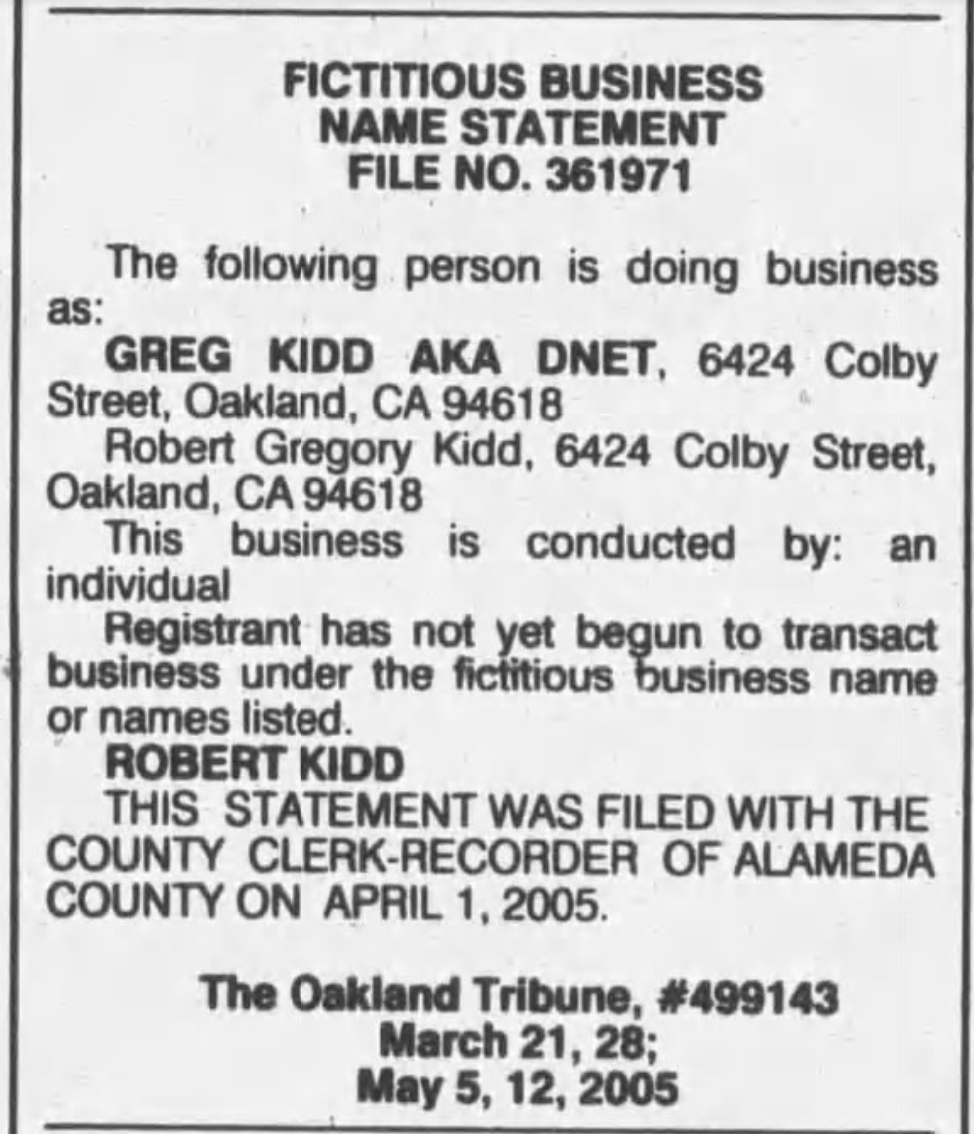
Dnet also added a link to “White Papers” in which the only document was an article about electronic checks thanks to the Check 21 Act.
2006: Jack Dorsey co-founds twitter and is made CEO.
August 21, 2006: Jack Dorsey tweets that his favorite fashion designer is Issey Miyake from Japan.
May 2007: The website for DNet, where Dorsey previously worked, is taken offline. It comes back online in Mid-October 2008 and offline for good in July 2009.
May 2007: The unknown creator of Bitcoin starts designing Bitcoin, at least according to when Satoshi Nakamoto claims he started.
May 25, 2007: The domain name Squareup.com is registered. It was parked at Sedo, which means it may have been owned by a domain name speculator.
June 6, 2007: Jack’s former employer at DNet (Greg Kidd) who has now left the Federal Reserve and had just invested in Twitter, tweeted that Jack had big deals in the pipeline.
Talked to jack tonight. Big deals for him in the pipeline
— Greg Kidd (@gregkidd) June 6, 2007
January 9, 2008: Jack announced renewing the domain gu.st from the island of S.
renewing http://gu.st/ from the island of S
— jack (@jack) January 10, 2008
January 16, 2008: Twitter launches an official Japan service. As Jack said “We’re turning Japanese!”
We're turning Japanese!: http://tinyurl.com/2an79w
— jack (@jack) January 16, 2008
July 8, 2008: Jack ponders a visit to Tokyo in October to see his favorite band Radiohead
May have to go to Tokyo in October. For Radiohead, of course.
— jack (@jack) July 8, 2008
July 10, 2008: Erik Westra, who became DNet’s lead programmer in 2001, goes dark on twitter after tweeting about work on the defunct company almost daily for months. He would not tweet again for more than 9 months.
July 17, 2008: Jack Dorsey resumes tweeting about his favorite bar and restaurant, named Nihon (which is Japanese for Japan). He tweeted about it several times in 2006 and then no tweets about it until July 17, July 25, 2008, August 4, 2008, and April 9, 2009. He never tweets about it again after those dates.
July 20, 2008: The domain e-cash.org is registered, with some experts speculating that Satoshi originally intended to name his project e-cash instead of Bitcoin.
July 26, 2008: Jack Dorsey tweets out a link to a cryptography manifesto website. cr.yp.to
@nkallen I can point at it. See http://cr.yp.to
— jack (@jack) July 26, 2008
August 2008: A twitter board member accidentally emailed Dorsey about the Board’s plans to oust him as CEO.
August 12, 2008: Jack tweets: “Closer, but not there yet. To be continued at home.”
August 15, 2008: Jack tweets using the word bit: “A bit of programming before bed.”
August 17, 2008: Netcoin.org is registered using the same info that would be used the following day.
August 18, 2008: The Bitcoin.org domain name is registered. It was registered to [email protected] at 1-3-3 Sakura House in Nakano-ku, Tokyo-to with a Finnish phone number. (+50 international code).

August 20, 2008: “[email protected]” emails the creator of Hashcash, Adam Back, to tell him he is going to cite his work in an upcoming paper. Whoever Satoshi is, he has adopted a persona of being Japanese.
August 22, 2008: Satoshi emails Wei Dai on the advice of Adam Back.
September 8, 2008:
Confident because I have a plan in my back pocket.
— jack (@jack) September 8, 2008
September 10, 2008: In about 2 months from this day it will be revealed that Satoshi Nakamoto’s pre-release bitcoin software demo had its own genesis block with a unix timestamp of 1221069728, or September 10, 2008.
Excited.
— jack (@jack) September 10, 2008
October 5, 2008: Satoshi registers his first account on SourceForge under the name Nakamoto2. (Nakamoto was already taken).
October 15, 2008: Dorsey is ousted as CEO for focusing too much of his time on “hobbies” outside of twitter.
October 20, 2008: Interesting timing of this tweet:
"Don't make something unless it is both necessary and useful; but if it is both, don't hesitate to make it beautiful."
— jack (@jack) October 20, 2008
October 30, 2008:
• Twitter informs Mark Zuckerberg that it will not sell itself to Facebook
• Dorsey’s personal gu.st website goes offline.
@jack hey, your site gu.st is not responding fyi!
— ilan abehassera (@ilan) October 30, 2008
October 31, 2008: Someone using the name “Satoshi Nakamoto” publishes a White Paper, Bitcoin: A Peer-to-Peer Electronic Cash System to a cryptography mailing list. Satoshi gives a code example in the 9-page document written in C.
Converting to C code…
#include
double AttackerSuccessProbability(double q, int z)
{
double p = 1.0 – q;
double lambda = z * (q / p);
double sum = 1.0;
int i, k;
for (k = 0; k <= z; k++) { double poisson = exp(-lambda); for (i = 1; i <= k; i++) poisson *= lambda / i; sum -= poisson * (1 - pow(q / p, z - k)); } return sum; }
C is the absolute best. rust a close second.
— jack (@jack) June 2, 2022
The very first Twitter prototype (email only) was written in C for this device (850) in 2000: http://tinyurl.com/7uclgz. Thank you, RIM.
— jack (@jack) January 13, 2009
“Commerce on the Internet has come to rely almost exclusively on financial institutions serving as trusted third parties to process electronic payments,” Satoshi wrote. “While the system works well enough for most transactions, it still suffers from the inherent weaknesses of the trust based model. Completely non-reversible transactions are not really possible, since financial institutions cannot avoid mediating disputes.”
Satoshi would also regularly write with an American English bent with an occasional UK spelling thrown in (which appears designed to throw a reader off his scent). The choice of UK spelling could be a tribute to his favorite writers and music (Common and Radiohead).
Jack-Dor-sey
Sa-to-shi
The bitcoin paper came out the same month that Jack said he’d like to be in Tokyo.
December 5, 2008:
It's working.
— jack (@jack) December 5, 2008
December 8, 2008:
Excited about 2009. Massive innovations to come.
— jack (@jack) December 9, 2008
December 9, 2008:
"Great things in business are not done by one person, they are done by a team of people."
— jack (@jack) December 9, 2008
December 10, 2008: Bitcoin’s mailing list is launched.
Satoshi registers his second SourceForge account, under the name s_nakamoto. He linked both SourceForge accounts he had to Bitcoin.
January 2, 2009:
Programming and testing.
— jack (@jack) January 2, 2009
Writing a NDA and then going for a walk.
— jack (@jack) January 3, 2009
January 3, 2009: First bitcoin block is mined.
January 9, 2009: Bitcoin v0.01 source code is pubished by Satoshi.
January 10, 2009 Satoshi accidentally logged into IRC using a real IP address in California. While some people later traced the IP (68.164.57.219) to being possibly in the Los Angeles area, the IP many have been managed by a company based in San Jose at the time. Unfortunately, the first attempt to track this came six years after it happened which makes tracking it almost impossible. Dorsey, who was at an award show the night before in San Francisco, would have only been a 1 hour drive away from San Jose and the surrounding areas of Silicon Valley that day. He frequently tweeted around that time that he was making day trips to Palo Alto. At the very least we know that Satoshi was in California that day, where Jack was.
January 11, 2009: On this day, Satoshi Nakamoto conducted the first bitcoin transaction by sending bitcoins to Hal Finney at 10:30pm ET. January 11th happens to be Jack Dorsey’s mother’s birthday which only becomes suspiciously coincidental when you read down and later discover what happened on Jack’s father’s birthday in 2010. The Finney family later confirmed the transfer time of January 11th.
January 13, 2009: Jack wants everyone to know that he codes in C, which is what the Bitcoin White Paper referenced even though Bitcoin itself was later coded with C++.
The very first Twitter prototype (email only) was written in C for this device (850) in 2000: http://tinyurl.com/7uclgz. Thank you, RIM.
— jack (@jack) January 13, 2009
January 16, 2009:
Build something quick & dirty first. If it doesn't *feel* electric when you use it, move on & build something else.
— jack (@jack) January 16, 2009
February 5, 2009: The idea for a credit card reader attached to an iPhone is formed (which would become the basis for Square). Jack got the idea from Robert Morley, after sharing his own idea about an OCR reader using a phone’s camera.
February 11, 2009: Tristan O’Tierney begins working on the iPhone software in Jack’s apartment.
Satoshi announces Bitcoin to the P2P Foundation forums and includes in his profile that he is located in Japan.
Same day:
I have assembled a team & work has begun.
— jack (@jack) February 11, 2009
February 23, 2009 Block 5353 which shares numerology with Jack’s dad’s birthday (since he was born 5/3/53) was mined to this Satoshi wallet: 14dbyDbrb7mbAADSBrDYPrjZT1YfCqZBRR. It start’s off with 4dby, i.e. for dad’s birthday.
February 2009: Jack lays groundwork for Square with a scribble of the first smart phone payment device.
February 2009: The beginnings of Square were said to have started after Jack Dorsey’s friend Jim McKelvey met with a professor and card reading specialist named Robert Morley on February 5th. Jack had previously envisioned an iPhone credit card reader using the camera and OCR in January. On February 11th, Jack had a software developer friend named Tristan O’Tierney begin work on the project in his apartment. Jack’s original name for the project was “Pay By Squirrel” instead of Square.
March 6, 2009: Square, known as Squirrel, officially starts in its new office.
April 17 – April 24, 2009: Jack is part of an official US State Department delegation to Iraq.
– April 19:
- 2:14 am Satoshi sends last email for a long while
- 2:34 am Jack tweets out that they are about to leave Jordan to finally go to Iraq
- 6:47 am Jack tweets out that he’s getting on the plane
- 9:02 am Jack tweets out that he has landed in Iraq
– April 20-24
- Jack is in Iraq. Satoshi does not post anywhere or email anyone
- Jack lands in New York City on April 24 and says he will be there a couple days
April 27, 2009
– Jack says he is finally back home in San Francisco.
– Satoshi returns to using email after an 8-day gap.
May 8, 2009: Rumors about Jack’s new payment startup “Squirrel” leaks to the press.
Squirrel aka Square registers a Github account.
May 13, 2009: Jack Dorsey registers a Github account to follow Square.
June 14, 2009: Satoshi writes in an email: “Thanks, I’ve been really busy lately.”
July 21, 2009: Satoshi says in an email that he’s been really busy and that Bitcoin really needs a purpose for people to use it. “I’m not going to be much help right now either, pretty busy with work, and need a break from it after 18 months development. It would help if there was something for people to use it for. We need an application to bootstrap it. Any ideas?”
Jack Dorsey was busy indeed as July 1 was the official grand opening of Sightglass Coffee in San Francisco, a coffee shop that he was not only an investor in, but one that happened to also be the third business in history to accept credit cards with Square.
A first look at @Sightglass making a cappuccino! We're opening the coffee bar within 7 days. http://bit.ly/chyOR
— jack (@jack) June 24, 2009
Big news: @Sightglass is opening tmrw at 8am in SF! Stop by for some coffee & a peek. 270 7th at Folsom.
— jack (@jack) July 1, 2009
August 14: Satoshi’s computer that he was using to mine bitcoin himself goes offline starting on this day and would not go back online until 10 days later.
August 24: Satoshi’s computer that he was using to mine bitcoin himself comes back online and resumes mining. Satoshi’s mining software left a signature (known as the Patoshi pattern) that was later used to trace 1.1 million in bitcoin rewards that had been earned by Satoshi himself.
December 1, 2009: The Square website goes live on Squareup.com. Its first official logo is a blue square inside a blue square, though if one stayed on the homepage long enough, the logo would eventually shift colors in an animated fashion. However, the default color was blue.
December 11, 2009: Satoshi debates design elements in an email and concludes for the new bitcoin site layout he picked out: “Maybe it’s just me, but I really like the random blue squares.
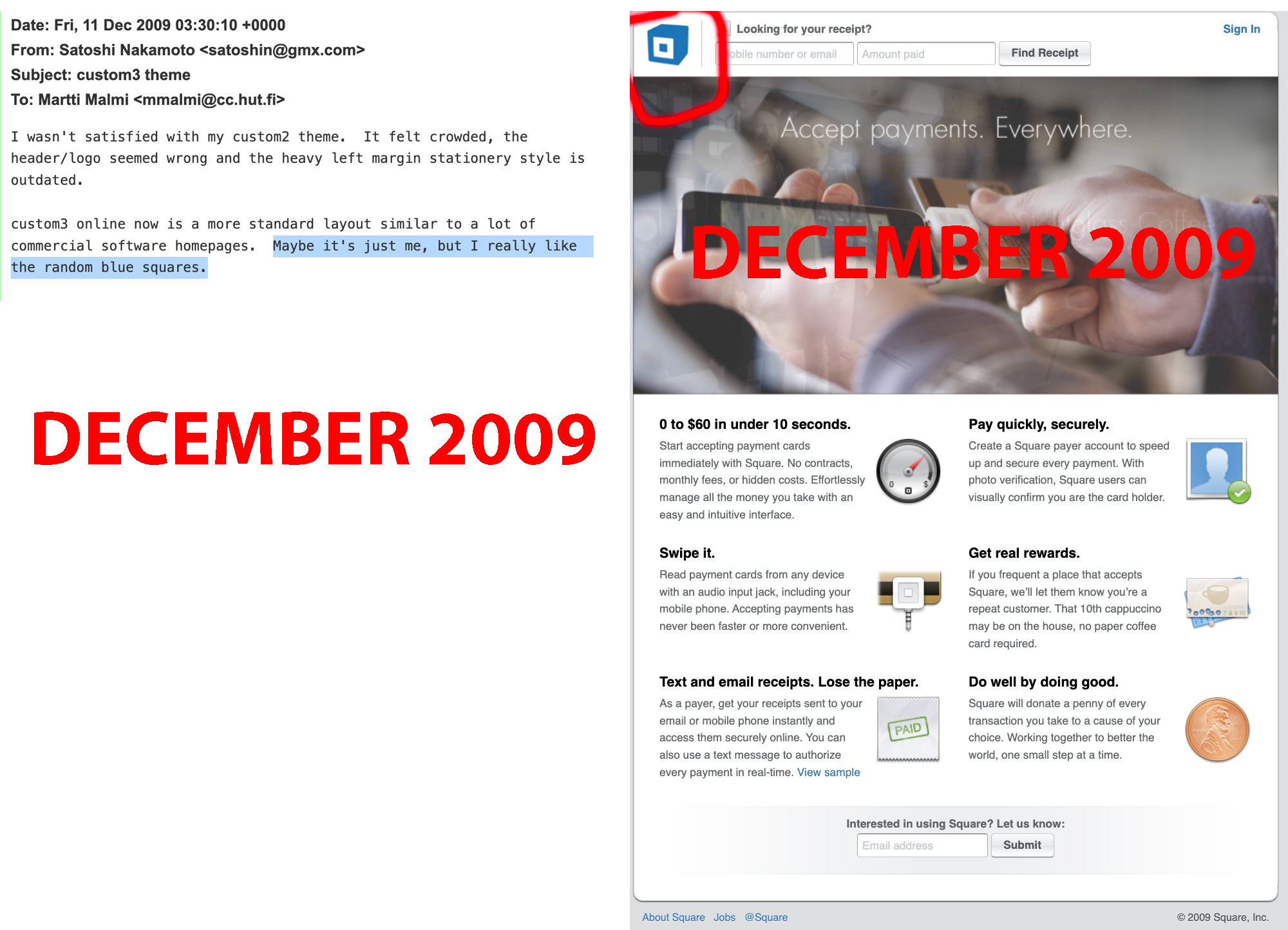
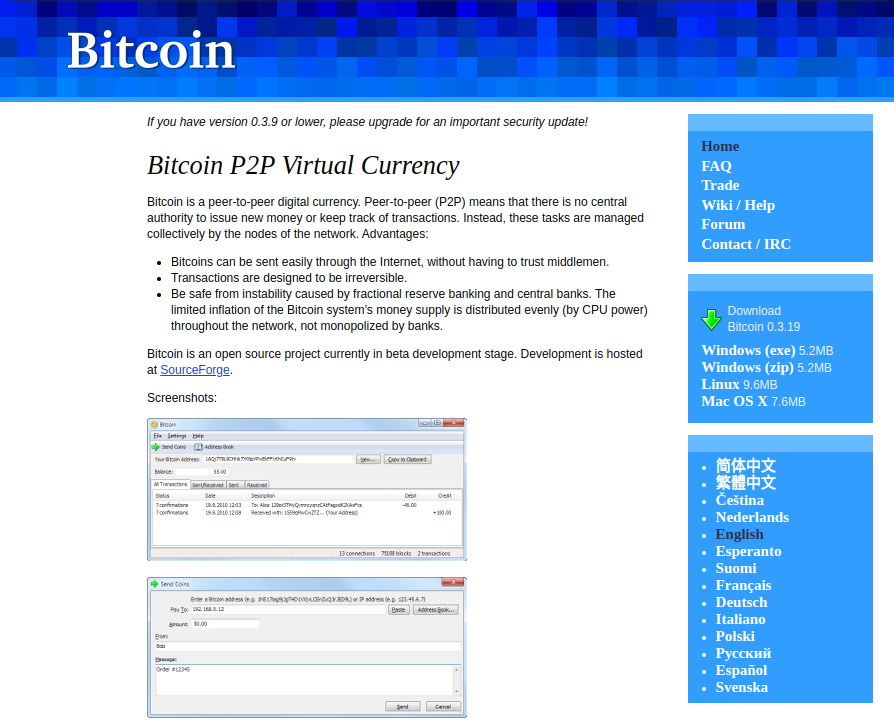
February 16 – 23, 2010: Jack is part of an official US State Department delegation to Russia. Satoshi continues to post online during this time.
April 1, 2010: Satoshi takes an apparent 1.5 month break from Bitcoin after saying in an email that he had gotten too busy “with other things.” He also had no posts on the Bitcointalk forum between March 24, 2010 and May 16, 2010. On May 16th, he said that he had only just started downloading all his emails since early April.
May 3, 2010: Satoshi’s unique mining software goes offline permanently after block 54,316.
May 3, 5/3 is Jack Dorsey’s father’s birthday. Jack’s father’s twitter name is @Tim535353.
Happy birthday to my dad, @Tim535353!
— jack (@jack) May 3, 2010
Shortly after midnight on that day, Jack Dorsey tweets “On to the next one.”
On to the next one.
— jack (@jack) May 4, 2010
May 11, 2010: Square announces the debut of its mobile phone readers and begins shipping them out.
RT @jack Today we're releasing @Square's iPhone & Andriod clients, and sending square readers! https://squareup.com
— Square (@Square) May 11, 2010
May 16, 2010: Satoshi returns to Bitcoin emails and the bitcointalk forum.
Satoshi writes in an email: “I’ve also been busy with other things for the last month and a half. I just now downloaded my e-mail since the beginning of April. I mostly have things sorted and should be back to Bitcoin shortly.”
July 18, 2010: Satoshi writes in an email:
“I’m losing my mind there are so many things that need to be done.”
October 1, 2010: Jack summoned co-founder Biz Stone to return to the US from Japan to participate in the engineered ouster of Evan Williams as CEO of twitter. Dick Costolo takes over as CEO and Jack is preparing to make a major return to the company.
December 5, 2010: Satoshi is upset that people are donating Bitcoins to Wikileaks as an end-run to finance Wikileaks after they got cut off from the financial system.
“No, don’t “bring it on”.
The project needs to grow gradually so the software can be strengthened along the way.
I make this appeal to WikiLeaks not to try to use Bitcoin. Bitcoin is a small beta community in its infancy. You would not stand to get more than pocket change, and the heat you would bring would likely destroy us at this stage.
December 12, 2010: Satoshi makes his last intended public post. A day earlier he explained why. It was because of Wikileaks.
“It would have been nice to get this attention in any other context,” he wrote. “WikiLeaks has kicked the hornet’s nest, and the swarm is headed towards us.”
December 14, 2010: Twitter is subpoenaed over Wikileaks.
Early 2011: Satoshi adds an age to his profile, stating that he is 35 years old. The birth date is later identified as April 5, 1975. April 5 (1994) is the day that Kurt Cobain died.
A pen stipple drawing of Kurt Cobain I did just before he committed suicide at 27. pic.twitter.com/KAs3TO03
— jack (@jack) November 10, 2011
March 28, 2011: Jack returns to twitter as Executive Chairman while stating that he’ll be remaining CEO of Square.
Today I'm thrilled to get back to work at @Twitter leading product as Executive Chairman. And yes: leading @Square forevermore as CEO. #200%
— jack (@jack) March 28, 2011
April 23, 2011: Satoshi sends his last ever email, saying “I’ve moved on to other things. It’s in good hands with Gavin and everyone.”
May 23, 2011: Twitter’s Tech Lead, Florian Leibert, hints that Square would be integrating Bitcoin payments.
I wonder when / if @square will handle bitcoin payments
— Florian Leibert 🎢 (@flo) May 23, 2011
May 30, 2011: The official Bitcoin Sourceforge page for Bitcoin (which Bitcoin used prior to the creation of the bitcointalk forum) includes a twitter widget for people to talk about Bitcoin on twitter.
November 10, 2011: Jack Dorsey said that one of his favorite things to sketch was a tree in a Japanese Zen Garden.
January 12, 2012:
さよなら日本。 你好中國。 http://t.co/D5wcswJg
— jack (@jack) January 12, 2012
September 14, 2012:
Jack Dorsey, founder of twitter and Square: "Bitcoin is an amazing movement.." http://t.co/8UmliU8t
— BitCoin News (@BTCNews247) September 14, 2012
Jack Dorsey of Square on currencies/bitcoin:
"If it becomes huge and accepted in the world, Square will accept it"https://t.co/ga4ABp9l— Julian Noble (@electricwings) September 14, 2012
May 23, 2013: Japan was the first country that Square expanded to outside of the US.
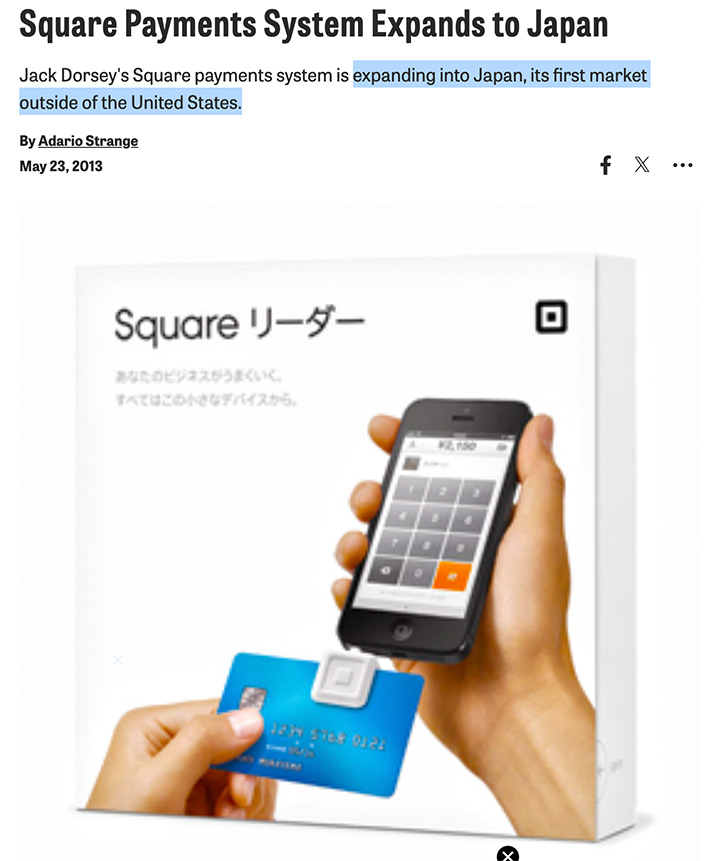
Square: now available in Japan. 🎏🎌🎋 http://t.co/JIsEyh98W3 https://t.co/cLU3mE4L6D
— jack (@jack) May 23, 2013
September 17, 2013 Jack Dorsey was asked about Bitcoin while on stage at Technonomy Detroit 2013. This was his answer:
“Bitcoin is a dream for a lot of mathematicians and folks who are into cryptography because it represents a truly anonymous currency that can’t be traced and is free. So I think there does need to be a digital equivalent to cash. I think it needs to be free and I do think it needs to be anonymous.”
To Jack: What do you mean by free?
“Not paying to exchange it. So cash is free to exchange […] I think it’s important to our democracy. I think anonymity is important to our democracy. We value anonymous communication in the form of whistle blowing which I think is a really important checkpoint to our government and to corporations existing in this nation and people, and currency is another form of — so we need to be able to replicate a paper-based currency in a digital way and Bitcoin is a potential answer, it’s got a lot of bad press because of a lot of negative uses, but it may mature. It may not be the one but there will be one eventually.”
September 19, 2013 Jack Dorsey’s previous partner and mentor, Greg Kidd, starts working at Ripple after a poker game with “The Deep State.”
March 31, 2014:
Have bitcoin? You can now spend it on Square Market! http://t.co/qLRtFs6QNp
— jack (@jack) March 31, 2014
September 2014: Satoshi’s GMX email is allegedly hacked. Leaked screenshots show that he was subscribed to PYMNTS.com, which reported on Square and Jack Dorsey regularly, but had never mentioned bitcoin until 2012.
https://t.co/SHuMsGwymk https://t.co/ktfNLPknwF
— Seán Murray (@financeguy74) October 19, 2024
Further, an allegedly leaked screenshot showed a receipt emailed to the account for an address in St. Louis, MO. That’s where Jack Dorsey was from, where Square was said to be founded, his friends, and where the co-founders of Square still lived. The seller on the invoice was CardReaderFactory, which was run by an international credit card skimming criminal named Alexandru Sovu, which might weaken this as legit evidence. However, the order was for a new state-of-the art Bitcoin mining tech, a Lancelot and CardReaderFactory was the only place it could be purchased at the time. In any case, that “St. Louis, MO” would be used on a document purporting to partially expose Satoshi’s identity cannot go ignored.
When Satoshi's GMX email was hacked in 2014, screenshots from his inbox were leaked. One of them is a famous invoice screenshot showing that a "Lancelot" was shipped from CardReaderFactory in the British Virgin Islands to an address in St. Louis, MO 63101 (downtown). The leaker… pic.twitter.com/yPdT3EBw9D
— Seán Murray (@financeguy74) October 19, 2024
Additionally, the creator of the Lancelot, said on the Bitcointalk forum that they had shipped everything out on the date in question, June 14, 2013.
July 2015: Jack is made interim CEO of twitter.
August 15, 2015:
Satoshi allegedly returns with an emotionally-charged email to the Bitcoin dev list. Some people contend this does not sound like Satoshi but the domain name and email headers checked out.
October 2015: Jack is made permanent CEO of Twitter.
December 29, 2016: Long before Bitcoin was ever considered an investment or digital gold, the wider tech industry saw Bitcoin as overlapping with payments (with no chargeback risk) and a threat to the legacy system. Here’s Jack getting defensive about Bitcoin being a competitor to Square.
square and bitcoin aren't competing. You're thinking of the card networks and their prices
— jack (@jack) December 30, 2016
November 2017: Square’s Cash App enables Bitcoin purchases.
December 6, 2018: Nothing to see here, just Jack doing Japanese things.
安倍晋三内閣総理大臣 @AbeShinzo に本日お会いできたことを嬉しく思います。日本の皆様に直接語りかけるツールとしてTwitterをご活用頂き、また気候変動をはじめとする地球規模の課題に指導力を発揮して頂き、感謝致します。🗾🏯🗻🎎🎌🌏
— jack (@jack) December 6, 2018
April 2020: Jack Dorsey denies that he is Satoshi on the Lex Fridman podcast. “When asked whether he was the person behind the pseudonym, which would add another technological innovation to his resume, Dorsey demurred. ‘No,’ he replied. ‘And if I were, would I tell you?'”
Dorsey, however, praised the calculated strategy of Satoshi’s constructed pseudonymous identity, saying that it allows everyone to feel like “we are all part of the story.” Further, when Dorsey was questioned if he could sacrifice his own ego for his own accomplishments, he said while touching his face, “I think the appreciation that comes from doing something good and being able to see it and see people use it is pretty overwhelming and powerful, more so than seeing your name in the headlines.”
October 8, 2020: Square invests $50 million in Bitcoin.
January 1, 2021: Tesla (owned by Elon Musk and who would later take over Twitter from Dorsey), acquired $1.5 billion in Bitcoin.
December 1, 2021: Square rebrands to Block, signaling his defining connection to the Blockchain.
January 11, 2022: Jack Dorsey emails the Bitcoin mailing list about forming the Bitcoin Defense Fund. It’s not only the anniversary of Satoshi’s first transaction but also Jack Dorsey’s mom’s birthday.
February 1, 2022:
Jack: “…we fixate a lot on Satoshi and I have nothing but gratitude for whoever this person is but there’s so much work that went into that to get to what Satoshi was able to do. There’s a whole background of engineering and science and experimentation and testing to get us to this point…”
June 10, 2022: Jack Dorsey-backed TBD company unveils blueprint for “web5.”
2023: Square sells $9.5 billion worth of Bitcoin in 2023.
July 25, 2023:
Jack: “Satoshi walking away and not touching their Bitcoin as far as we can tell benefiting from it from a value perspective perspective in any way, walking away at the onset of WikiLeaks using it which will tell you some things about why they may have walked way.”
July 21, 2023
Jack makes a rare public statement on who he believes Satoshi is, claiming that it’s Hal Finney, which has actually been mostly publicly disproven and was utterly refuted by Finney before he died. Source 1, Source 2, Source 3, Source 4, Source 5, Source 6, Source 7. Jack’s assertion in it being Hal then sounds more like tribute to the man that helped with his code and for being the recipient of the first transaction.
“Hal is Satoshi” – Jack Dorsey, on Nostr
October 27, 2023:
Host: “I know you’ve been asked before but I’m going to ask again, could you be Satoshi by any chance?
Jack: “No……I’m very grateful and If I knew who this person was or ever have the honor of meeting this person I would just say thank you because they reminded me of why I fell in love with the internet in the first place, why I fell in love with programming, why I fell in love with building and creating, and cryptography, and all cyberpunks, and Bitcoin and Satoshi in 2009 was a combination of my childhood and my curiosity and everything that I aspired to be and everything I loved. My life went a different track.”
February 4, 2024: Jack Dorsey leads the charge to make sure that an alleged impostor is not given the recognition as Satoshi.
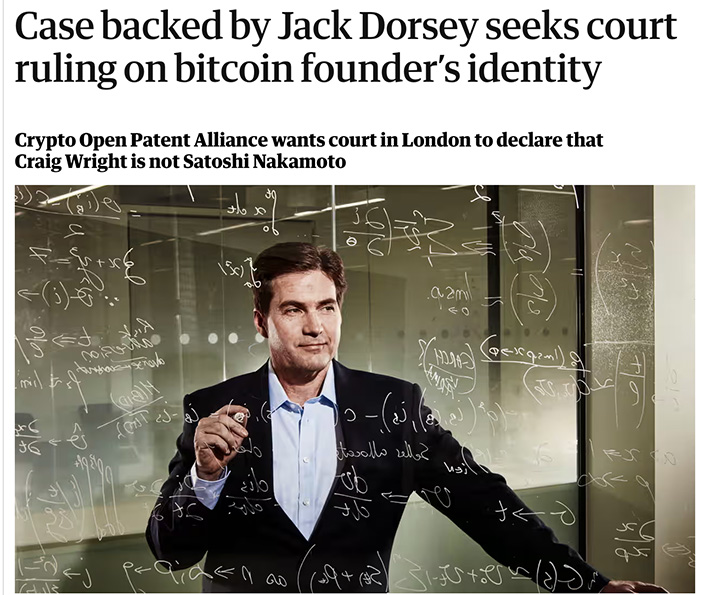
February 11, 2024: During live conference interview:
JUST IN: Jack Dorsey spotted wearing a Satoshi #Bitcoin shirt at the #SuperBowl 🏈 pic.twitter.com/oDUySC5p7X
— Bitcoin Magazine (@BitcoinMagazine) February 12, 2024
The shirts are for sale in lightning.store by Sam Means and anyone can buy one.
July 21, 2024
“i frequently imagine satoshi sitting back somewhere and laughing at it all” – Jack Dorsey on Nostr
August 28, 2024:
Jack thanking Hal Finney for his early help.
“thank you hal” – Jack Dorsey on Nostr
October 2024: A study into who is financing Bitcoin’s development revealed that Jack Dorsey is the primary financier of it. Full report here.
January 16, 2025: Jack on a podcast about Bitcoin using the same language as the 2015 Satoshi email about the potential for bitcoin to become “a failed project.”
“If this ends up just being digital gold, I think it’s failed. I don’t think it has a life. If it ends up being a currency that people can use on a daily basis then it’s succeeded. You have to go back to the White Paper. This is P2P Electronic Cash, and we have not realized that yet and that’s why I’m in it, I’m not in it to create digital gold and just watch a number go up like I want to be able to use it, I want everyone in the world to not have to ask for permission to move money, and to have to ask their bank whether they can deposit something or withdraw. If we don’t achieve that like it’s a failed project and we should move on to something else.” – Jack
January 21, 2025
Jack on the Citadel Dispatch podcast
“Really when I was a kid, I loved alt.cypherpunks. I loved Usenet, I loved what those guys were doing. I followed the mailing list. Wired back in the day, was like wild, like it was underground back then, and it was following all that activity, starting with PGP and Philip Zimmerman, and exporting the code by Adam Back on a t-shirt in Perl, like all that was just like, that was my joy. I wasn’t working in that space, but it was my joy.”
Other facts about Jack Dorsey:
He was the founder of Postcardx.net in 2001. He took it offline in September 2008, a month before the Bitcoin White paper was introduced. The old official chat group about it can be found here. He also ran funkd.net as a mirror of his blog at gu.st and tasklist.net as a mirror of his site trakcore.net. And in 1997 he operated the domain transicode.org with an email of [email protected].
He was the creator of SearchGoogle.service, a Mac OS tool that made Google searching easier.
He was the founder of saintlist.com, a Craigslist clone for St. Louis, MO in 2003.

